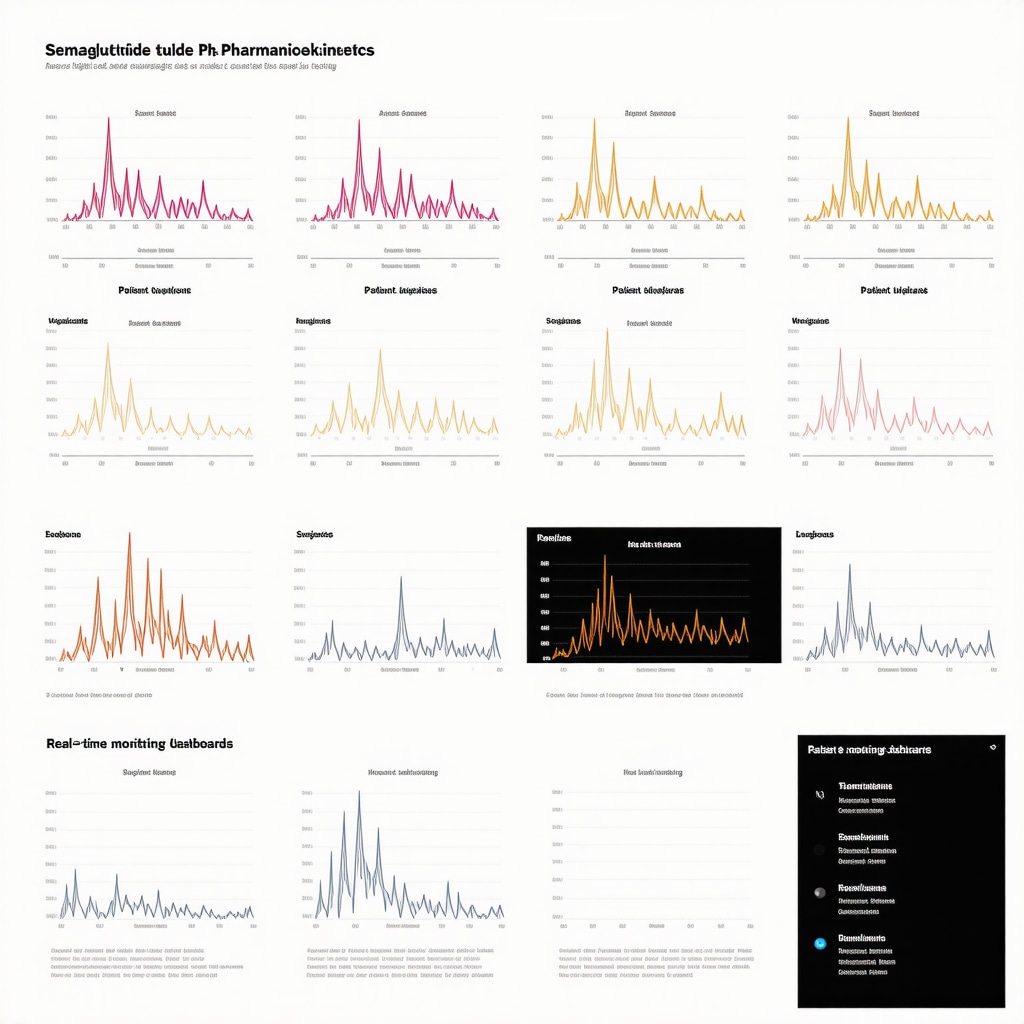Understanding the Mechanisms Behind FDA Approved Semaglutide Drugs
Semaglutide, a glucagon-like peptide-1 (GLP-1) receptor agonist, has emerged as a groundbreaking pharmacological intervention for obesity and weight management. Its FDA approval underscores significant advancements in metabolic disease treatments, leveraging its dual role in appetite suppression and enhanced insulin secretion. By mimicking endogenous incretin hormones, semaglutide effectively modulates central nervous system pathways controlling satiety, thus reducing caloric intake and promoting sustained weight loss.
Clinical Efficacy and Weight Loss Outcomes in Semaglutide Therapies
Robust clinical trials, including the STEP program, have demonstrated that FDA approved semaglutide drugs can induce an average weight loss exceeding 15% of baseline body weight over 68 weeks, markedly surpassing traditional anti-obesity medications. These outcomes are attributed not only to appetite regulation but also to delayed gastric emptying and improved glycemic control, which synergistically optimize metabolic health. Moreover, semaglutide’s once-weekly injectable formulation enhances patient adherence, a critical factor in long-term weight management success.
What Are the Differential Benefits Among Various FDA Approved Semaglutide Formulations?
Multiple semaglutide formulations, such as Wegovy and Ozempic, present nuanced differences in dosing regimens and indications. Wegovy is FDA-approved specifically for weight management in adults with obesity or overweight with comorbidities, delivering higher doses optimized for fat loss. In contrast, Ozempic primarily targets type 2 diabetes but also confers significant weight reduction as a secondary benefit. Understanding these distinctions allows clinicians to tailor therapy based on patient profiles and treatment goals.
Advanced Considerations: Safety Profiles and Long-Term Implications
While semaglutide exhibits a favorable safety profile, including low incidences of gastrointestinal adverse effects and minimal hypoglycemia risk, ongoing pharmacovigilance is essential. The long-term metabolic and cardiovascular benefits are promising but warrant further real-world evidence to confirm sustained efficacy and safety. Clinicians must also consider patient-specific contraindications and monitor for rare but serious adverse events, maintaining a balance between therapeutic gains and potential risks.
Integrating Semaglutide with Lifestyle Interventions for Enhanced Outcomes
Combining FDA approved semaglutide drugs with structured lifestyle modifications, including dietary optimization and physical activity, potentiates weight loss efficacy. Evidence suggests that strategic approaches like intermittent fasting synergistically augment semaglutide’s fat-burning effects by enhancing metabolic flexibility and reinforcing appetite control mechanisms. Such integrative regimens exemplify precision medicine in obesity management, maximizing patient-centered outcomes.
Evidence-Based Resources and Continuing Developments
For comprehensive clinical insights and safe administration guidelines on semaglutide therapies, specialists are encouraged to consult authoritative resources such as the detailed clinical reviews available here. Additionally, the American Diabetes Association and peer-reviewed journals provide continually updated data reflecting evolving practices in GLP-1 receptor agonist use.
Explore Further and Share Your Expertise
If you are a healthcare professional or researcher, consider contributing your clinical experiences or reviewing advanced treatment protocols at our expert forum. Collaborative knowledge exchange is vital for optimizing semaglutide’s role in combating the obesity epidemic.
According to a 2021 New England Journal of Medicine study, semaglutide significantly improves weight loss outcomes and metabolic parameters, reinforcing its authoritative position in contemporary obesity therapeutics.
Precision Dosing: Tailoring Semaglutide for Individual Patient Needs
Optimizing the dosage of FDA approved semaglutide drugs is pivotal for balancing efficacy and safety. Clinical evidence supports initiating treatment with a low dose, such as 0.25 mg weekly, gradually escalating to maintenance doses ranging from 1 mg to 2.4 mg depending on the indication and patient tolerance. This stepwise titration minimizes gastrointestinal side effects while promoting sustained appetite suppression and fat oxidation. Clinicians must adopt a personalized approach, considering patient-specific factors such as baseline BMI, comorbidities, and metabolic responses to fine-tune dosing protocols effectively.
Moreover, emerging data emphasize the importance of adherence to recommended dosing intervals. Weekly semaglutide injections maintain stable plasma concentrations, ensuring continuous receptor engagement and optimized metabolic outcomes. Deviations from this schedule can compromise therapeutic benefits and increase adverse event risks. For comprehensive guidance on safe dosage and administration, healthcare providers can refer to detailed protocols outlined in doctor-supervised semaglutide dosage guidelines.
Synergistic Approaches: Combining Semaglutide with Nutritional and Behavioral Interventions
Maximizing weight loss outcomes entails integrating semaglutide pharmacotherapy with evidence-based lifestyle modifications. Nutritional strategies emphasizing low-glycemic index foods, balanced macronutrients, and caloric restriction complement semaglutide’s appetite-regulating mechanisms by further reducing hunger cues and improving metabolic flexibility. Behavioral interventions, including cognitive-behavioral therapy and habit formation techniques, support long-term adherence and mitigate psychological barriers to weight loss.
Recent studies highlight the potent synergy achieved by coupling semaglutide with intermittent fasting protocols. This combination optimizes fat utilization and insulin sensitivity, enhancing overall metabolic health. For an in-depth exploration of these strategies, see semaglutide and intermittent fasting synergy.
How Can Clinicians Effectively Monitor and Adjust Semaglutide Therapy to Sustain Long-Term Weight Loss?
Effective monitoring of semaglutide therapy involves a multifaceted approach encompassing regular assessment of weight trends, metabolic parameters, and adverse effects. Clinicians should schedule periodic evaluations every 4 to 12 weeks during dose escalation and maintenance phases, adjusting dosage or adjunct therapies accordingly. Biomarkers such as HbA1c, lipid profiles, and liver enzymes offer objective insights into metabolic improvements or complications.
Patient-reported outcomes, including appetite changes, gastrointestinal tolerance, and quality of life measures, are equally critical for tailoring ongoing treatment. Incorporating digital health tools and telemedicine can enhance real-time monitoring and patient engagement, facilitating timely interventions and sustained weight management.
Emerging Research and Future Directions in Semaglutide-Based Therapies
Cutting-edge research continues to unravel semaglutide’s potential beyond weight loss, including cardiovascular risk reduction and neuroprotective effects. Longitudinal studies and real-world data will be essential to validate these benefits and refine treatment algorithms. Moreover, combination therapies pairing semaglutide with other metabolic agents are under investigation to amplify therapeutic outcomes.
According to a 2023 review published in Nature Reviews Endocrinology, semaglutide demonstrates promising cardiovascular and metabolic benefits, reinforcing its integral role in comprehensive obesity management strategies.
Engage with the Community: Share Your Insights and Experiences
We invite healthcare professionals, researchers, and patients to share their insights, questions, and success stories related to semaglutide use in weight management. Join the conversation through comments or by visiting our contact page to contribute to evolving clinical practices and patient-centered care.
Precision Monitoring Protocols: Enhancing Semaglutide’s Clinical Effectiveness Through Dynamic Patient Assessment
Implementing a rigorous monitoring framework is essential for maximizing the therapeutic potential of FDA approved semaglutide drugs. Beyond routine weight tracking, a comprehensive evaluation paradigm integrates biochemical markers, patient-reported outcomes, and digital health analytics. For example, periodic measurement of HbA1c provides critical insight into glycemic control, especially in patients with concurrent type 2 diabetes, while lipid panels and liver function tests help identify metabolic shifts and potential hepatotoxicity.
Clinicians are increasingly leveraging telemedicine platforms and mobile health applications to capture real-time data on adherence, side effects, and lifestyle behaviors. Such tools facilitate proactive dose adjustments and behavioral support, mitigating common barriers like gastrointestinal discomfort or early treatment discontinuation. The multidimensional feedback loop established through these modalities promotes individualized care trajectories and sustained weight loss maintenance.
What Are the Best Practices for Adjusting Semaglutide Dosage in Response to Variable Patient Tolerability and Weight Loss Plateaus?
Adjusting semaglutide dosage requires a nuanced understanding of pharmacodynamics and patient-specific factors. Initiation at lower doses with gradual escalation minimizes adverse effects, but clinicians must remain vigilant for signs of treatment plateau—defined by stagnation in weight loss despite adherence. In such cases, dose optimization strategies may include extending the titration period, augmenting the maximum dose within approved limits, or integrating adjunctive therapies such as GLP-1 receptor co-agonists.
Moreover, patient education on managing transient gastrointestinal symptoms through dietary modifications and hydration can improve tolerability, allowing continuation at efficacious doses. Collaborative decision-making, supported by clinical guidelines and emerging evidence, empowers clinicians to tailor interventions dynamically, balancing efficacy with quality of life considerations.
Integrating Pharmacogenomics: The Future of Personalized Semaglutide Therapy
Emerging research into the pharmacogenomic determinants of semaglutide response heralds a paradigm shift towards precision obesity therapeutics. Genetic polymorphisms affecting GLP-1 receptor expression, incretin signaling pathways, and drug metabolism enzymes may explain interindividual variability in efficacy and side effect profiles. Incorporating genotypic screening could enable pre-treatment stratification, optimizing both dose selection and patient counseling.
For instance, variants in the GLP1R gene have been linked to differential weight loss outcomes and gastrointestinal tolerance, suggesting a potential biomarker for clinical decision-making. While such applications are not yet standard practice, ongoing clinical trials and translational studies underscore the feasibility and utility of integrating pharmacogenomic data into semaglutide prescribing algorithms.
Health systems equipped with genomics infrastructure stand at the forefront of this innovation, potentially reducing trial-and-error approaches and enhancing cost-effectiveness in obesity management.
Addressing Complex Comorbidities: Navigating Semaglutide Use in Multi-Morbid Patient Populations
Obesity frequently coexists with multifaceted comorbidities such as cardiovascular disease, nonalcoholic fatty liver disease (NAFLD), and obstructive sleep apnea, complicating therapeutic planning. Semaglutide’s pleiotropic effects present both opportunities and challenges in these contexts. For example, its demonstrated capacity to reduce major adverse cardiovascular events (MACE) provides a compelling rationale for use in high-risk populations, yet careful assessment is warranted to avoid drug interactions and exacerbation of underlying conditions.
Multidisciplinary collaboration is critical; endocrinologists, cardiologists, hepatologists, and sleep specialists should coordinate to harmonize treatment goals and monitoring strategies. Adjustments in semaglutide dosing or adjunctive therapies may be necessary based on organ function, concomitant medications, and patient tolerance. Real-world evidence and registries are invaluable in refining these protocols, supporting evidence-based customization.
Advancing Clinical Practice: Leveraging Real-World Data and Artificial Intelligence in Semaglutide Therapy Optimization
The integration of real-world data (RWD) and artificial intelligence (AI) analytics is revolutionizing semaglutide clinical management. Large-scale electronic health record (EHR) datasets provide granular insights into patient heterogeneity, adherence patterns, and long-term outcomes outside controlled trial settings. Machine learning algorithms can identify predictors of response, flag early signs of adverse effects, and suggest personalized intervention pathways.
For instance, predictive modeling might forecast which patients are likely to achieve >15% weight loss or those at risk for gastrointestinal intolerance, enabling preemptive clinical actions. Furthermore, AI-driven decision support tools embedded in clinical workflows enhance provider confidence and streamline complex dosing adjustments.
These technologies promise to elevate semaglutide therapy from a one-size-fits-all model to a highly individualized treatment modality, improving efficacy and patient satisfaction.

Innovative Visualization: Mapping Semaglutide’s Pharmacokinetics and Patient Response Trajectories
Visual tools that dynamically illustrate semaglutide plasma concentration curves alongside patient-reported appetite metrics and weight trends offer transformative potential in clinical practice. Such integrative dashboards facilitate nuanced understanding of drug action timelines, adherence challenges, and response variability, fostering informed patient-provider discussions and shared decision-making.
Pharmacogenomic Insights: Unveiling Genetic Predictors of Semaglutide Response Variability
Recent advances in pharmacogenomics have begun to elucidate the complex genetic underpinnings that modulate patient responsiveness to semaglutide therapy. Variations in genes encoding the GLP-1 receptor (GLP1R), downstream signaling molecules, and metabolic enzymes critically influence both efficacy and tolerability profiles. For instance, polymorphisms such as rs6923761 in GLP1R have been associated with altered receptor sensitivity and differential weight loss trajectories, suggesting a compelling rationale for genotype-guided dose optimization. Integrating such genetic markers into clinical practice could transform semaglutide prescribing paradigms by enabling preemptive identification of patients likely to benefit from tailored dosing regimens or alternative adjunct therapies.
Artificial Intelligence-Driven Personalization: Leveraging Big Data for Adaptive Semaglutide Management
The burgeoning application of machine learning algorithms within obesity pharmacotherapy is revolutionizing semaglutide treatment individualization. By harnessing extensive real-world datasets encompassing demographic, biochemical, behavioral, and genomic variables, AI platforms can generate predictive models that forecast therapeutic outcomes and side effect risks with unprecedented precision. These data-driven insights facilitate dynamic adjustments in dosing, timing, and combination strategies, enhancing both efficacy and patient adherence. Moreover, AI-powered clinical decision support tools embedded within electronic health records streamline complex treatment algorithms, optimizing provider workflow and patient engagement.
How Can Emerging Biomarkers and AI Models Synergistically Enhance Semaglutide Therapy in Clinical Practice?
The confluence of biomarker discovery and AI analytics offers a transformative approach to semaglutide therapy optimization. Emerging biomarkers—including circulating incretin levels, metabolomic signatures, and genetic variants—provide objective metrics to stratify patients by predicted responsiveness and risk profiles. When integrated into machine learning frameworks, these biomarkers enable real-time, precision-guided titration protocols that anticipate treatment plateaus or adverse events. For example, AI models can identify subtle shifts in metabolic parameters or patient-reported outcomes, prompting preemptive dose modifications or adjunctive interventions. This synergy fosters a responsive, patient-centered treatment continuum, minimizing trial-and-error approaches and maximizing sustained weight loss and metabolic benefits.
Bridging the Gap: Clinical Implementation Challenges and Future Directions
Despite promising potential, the translation of pharmacogenomic and AI-informed semaglutide personalization into routine clinical workflows faces several hurdles. Standardization of genomic testing, data privacy considerations, and integration of AI outputs into clinician decision-making require robust infrastructural and regulatory frameworks. Collaborative efforts among healthcare providers, bioinformaticians, and policymakers are essential to establish validated protocols and reimbursement pathways. Furthermore, ongoing prospective studies are imperative to substantiate clinical utility and cost-effectiveness of these innovations.
For an authoritative perspective on AI applications in obesity pharmacotherapy, refer to the npj Digital Medicine review on artificial intelligence in obesity management, which delineates state-of-the-art methodologies and translational challenges.
Engage with Advanced Strategies: Propel Your Clinical Practice Forward
Healthcare professionals and researchers are encouraged to explore the integration of pharmacogenomic testing and AI-driven analytics within semaglutide treatment protocols. By embracing these cutting-edge innovations, clinicians can pioneer precision obesity therapeutics that transcend traditional paradigms. Connect with our expert community through the contact page to share insights, access specialized resources, and contribute to the evolution of semaglutide clinical management.

Expert Insights & Advanced Considerations
Precision Dosing as a Cornerstone for Maximizing Therapeutic Outcomes
Tailoring semaglutide dosage based on individual patient tolerance and metabolic response is paramount. Initiating treatment with conservative doses and methodically escalating allows clinicians to mitigate gastrointestinal side effects while achieving optimal weight loss efficacy. Incorporating dynamic monitoring tools ensures dose adjustments are evidence-driven and patient-specific, enhancing both safety and adherence.
Synergistic Integration of Semaglutide with Lifestyle and Nutritional Interventions
Combining semaglutide therapy with structured lifestyle changes — particularly intermittent fasting and balanced nutrition — potentiates metabolic benefits. This integrated approach leverages semaglutide’s appetite suppression alongside enhanced metabolic flexibility, resulting in accelerated and sustainable fat loss. Clinicians should emphasize multidisciplinary strategies to optimize long-term outcomes.
Emerging Role of Pharmacogenomics in Personalized Semaglutide Therapy
Genetic polymorphisms influencing GLP-1 receptor sensitivity and drug metabolism are increasingly recognized as determinants of patient response variability. Future incorporation of pharmacogenomic screening may enable clinicians to predict efficacy and adverse effect profiles preemptively, facilitating bespoke treatment plans and minimizing trial-and-error dosing.
Leveraging Artificial Intelligence for Dynamic Treatment Optimization
AI-driven analytics applied to real-world data are revolutionizing semaglutide management by enabling predictive modeling of individual response trajectories. Machine learning algorithms can assist clinicians in anticipating weight loss plateaus or side effects, guiding timely dose adjustments and adjunctive therapy integration, thereby elevating precision medicine in obesity management.
Managing Complex Comorbidities through Multidisciplinary Coordination
Patients with obesity often present with multifaceted comorbidities such as cardiovascular disease and NAFLD, necessitating coordinated care. Semaglutide’s pleiotropic effects offer therapeutic advantages but require careful interdisciplinary collaboration to balance efficacy with safety, adjust dosing, and monitor for potential interactions.
Curated Expert Resources
FDA Approved Semaglutide Clinical Insights Into Safe and Fast Weight Loss: A comprehensive clinical review offering detailed guidance on dosing, monitoring, and safety protocols designed for healthcare professionals seeking advanced understanding. (Read more)
Semaglutide and Intermittent Fasting: A Strategic Weight Loss Duo for 2025: Explores integrative strategies combining pharmacotherapy and nutritional timing to maximize fat burning and metabolic flexibility. Essential for clinicians aiming to implement holistic treatment plans. (Learn more)
Doctor-Supervised Semaglutide Safe Dosage Guidelines for Effective Results: Offers step-by-step protocols for dose titration and management of adverse effects, reinforcing patient safety while optimizing therapeutic gains. (Explore guidelines)
npj Digital Medicine Review on Artificial Intelligence in Obesity Management: Delivers insight into cutting-edge AI applications transforming obesity pharmacotherapy, including semaglutide personalization and real-time monitoring. (Access review)
New England Journal of Medicine Semaglutide Weight Loss Study (2021): Landmark clinical trial data validating semaglutide’s efficacy and safety in significant weight reduction. A foundational reference for evidence-based practice. (View study)
Final Expert Perspective
FDA approved semaglutide drugs have revolutionized obesity treatment by combining potent appetite regulation with metabolic improvements. Advanced clinical implementation now hinges on precision dosing, integration with lifestyle modifications such as intermittent fasting, and harnessing emerging pharmacogenomic and AI technologies to personalize therapy. Navigating complex comorbidities requires multidisciplinary collaboration to sustain therapeutic benefits safely. For clinicians and researchers dedicated to pushing the boundaries of obesity management, engaging with authoritative resources and innovative strategies is imperative for optimizing patient-centered outcomes. Explore more about maximizing semaglutide’s fat-burning potential and safe usage protocols by visiting our detailed guides and professional forums at our expert contact page. Your expertise and experience are invaluable in advancing this transformative field.


This post provides an excellent overview of semaglutide’s mechanisms and the importance of personalized dosing strategies. In my experience working with patients undergoing semaglutide therapy, I’ve observed that careful titration is crucial for minimizing gastrointestinal side effects while maximizing weight loss. I wonder how emerging pharmacogenomic data might further refine dose adjustments, especially for patients with genetic variations affecting GLP-1 receptor sensitivity. Has anyone here integrated genetic testing into their practice to tailor semaglutide treatments? It seems that combining genetic insights with AI-driven predictive models could truly transform obesity management, making therapies more effective and safer. I’d be interested to hear from clinicians who are exploring these innovative approaches—what challenges or successes have you encountered in implementing personalized semaglutide protocols?
This in-depth overview of semaglutide really highlights the impressive progress in obesity pharmacotherapy. I’ve seen firsthand how patient adherence improves significantly with the weekly injections, especially when combined with lifestyle changes like dietary adjustments and intermittent fasting. One challenge I’ve encountered is managing gastrointestinal side effects during dose escalation, which sometimes discourages patients early on. I’m curious about how others optimize the titration process to balance efficacy and tolerability. Have any clinicians adopted innovative strategies, perhaps leveraging digital health tools, to monitor patient responses more closely and adjust dosing in real-time? Additionally, the mention of pharmacogenomics is intriguing—do we have enough current data to start integrating genetic testing into routine practice, or is it still more of a future prospect? I’d love to hear experiences or insights from professionals navigating these emerging frontiers to personalize therapy further.